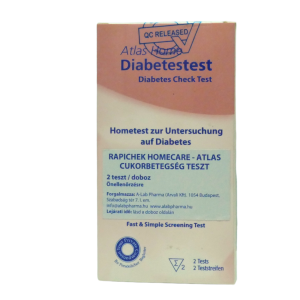Description
Gluten sensitivity (celiac disease), an autoimmune disorder of the small intestine. Common symptoms of gluten sensitivity include bloating and diarrhoea. The following symptoms can also be signs of gluten intolerance, such as weight loss, malnutrition and skin problems. The GlutenTEST can help you determine whether your symptoms are caused by celiac disease. The RapiChek HomeCare premium quality test kit is designed to detect the most common problems and infections in a professional environment or at home, in the comfort and discretion of your home.
GlutenTEST is suitable both for the initial diagnosis of gluten intolerance and for monitoring therapy. a-tTG-IgA antibody levels should decrease when gluten is removed from the diet. After 6 months on a gluten-free diet, antibodies often become undetectable. The doctor should confirm the diagnosis and make further recommendations for maintaining a gluten-free diet.
Each kit contains everything you need to perform the test: a test cassette, an instruction leaflet, a solution bottle with sample dilution buffer, 1 automatic sterile lancet for convenient blood collection, a glass capillary tube, a pipette, an alcohol pad and a sticking plaster. Results can be read within 10 minutes.
Background
Gluten sensitivity (coeliac disease), an autoimmune disorder of the small intestine where the immune system attacks the body’s own tissues. Common symptoms of gluten sensitivity include bloating and diarrhoea, caused by a reaction to the gluten proteins found in many foods. The following symptoms can also be signs of gluten intolerance, such as weight loss, malnutrition and skin problems.

EVALUATION OF THE TEST RESULTS
To read the result, all you need to do is check that there is a line at the Control (C) mark. The strength of the control line (C) is irrelevant.
POSITIVE TEST RESULT
If a faint or bright red control line appears below the (C) mark on the scoreboard, with a faint or bright red line next to it at the (T) mark, the test result is positive. This result means that the blood sample contains IgA antibodies indicative of gluten sensitivity, so the person taking the test is most likely to be gluten intolerant. Consult a doctor for a definitive diagnosis.
NEGATIVE TEST RESULT
If a faint or bright red control line is visible at the (C) mark on the scoreboard, but no line appears at the (T) mark, the test result is negative. This result means that the blood sample does not contain IgA antibodies indicative of gluten sensitivity. The test did not detect gluten sensitivity. If you notice any digestive tract abnormalities, please consult your doctor who may suggest further investigation.
INVALID TEST RESULT
If no test strip is visible at the (C) mark, or only at the (T) mark, the test has been performed incorrectly and the result is invalid. It is important that you follow the instructions for use of the test exactly. Do another test with a new blood sample.



